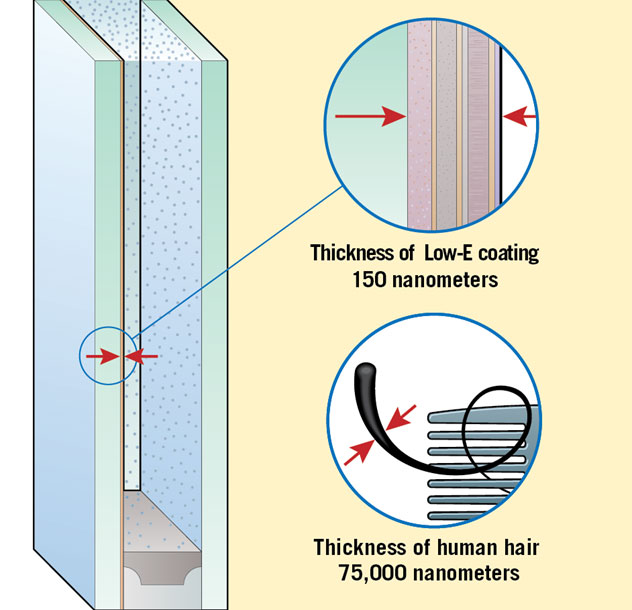The Components of Window Performance
Materials used to fabricate the four major components of an insulated glass unit (IGU) can dramatically affect energy performance. Here are a few things to consider about each component when shopping for windows.
Window Glass
Homeowners often think of window glass as a commodity product and that one pane of glass is the same as the next. However, the quality of the glass—and more specifically, the type of coating on it—can make a big difference in how much energy your home uses.
To maximize the energy performance of their window assemblies, or to meet specification standards such as ENERGY STAR®, manufacturers typically apply a low-emissivity (low-e) coating to the second or third surface of a single glass pane in a double-pane IGU, or to multiple surfaces in a triple-pane IGU.
What are Low-E Coatings?
Low-e coatings are made with microscopically thin layers of silver that are baked into window glass to block heat and transmit light.

Glass engineers can manipulate these coatings to give windows specific performance properties such as solar control, visible light transmittance (VLT) or insulating strength to optimize their performance in specific climate zones.
Solar Control vs. Passive Low-E Glass
There are two basic categories of low-e glass coatings:
- Solar control low-e glass coatings have high solar heat gain coefficients (SHGCs), meaning they block most of the sun’s heat from entering a home. They are the best choice for warm, air-conditioning-dominated climates.
- Passive low-e glasses are engineered to insulate homes in cold, heating-dominated climates by transmitting solar heat and preventing the escape of furnace heat through the window. They typically have U-factors of less than 0.30, but are available with U-factors of 0.20 or less.
To learn more about SHGC, U-factors and R-values, visit our Guide to ENERGY STAR Criteria.
Framing Systems
The performance of window glass can be strengthened or diminished by the performance of the framing system. IGUs are fabricated using a variety of framing materials such as fiberglass, vinyl, aluminum, wood, hybrid and composite frames.
Fiberglass frames generally insulate better than wood or vinyl, yet all three are better insulators than aluminum. The performance of vinyl frames often is enhanced by the injection of foam into the window sash.

Insulating Spacers
IGUs incorporate insulating spacers made from metal or foam that provide structural integrity and keep panes of glass at proper distances from one another. These devices further enhance the energy performance of IGUs by sealing in insulating gases such as argon or krypton.
Many consider metal spacers to be superior because they are physically stronger and last longer than foam spacers, which tend to dry out and crack over time, causing windows to lose their insulating capacity.
The primary advantage associated with foam spacers is that they do not conduct hot or cold air from the outdoors to the indoors, yet metal spacer systems such as Intercept® “warm-edge” spacers have been shown to prevent temperature transfer as effectively as foam spacers.
Intercept® warm-edge spacers are also designed to expand and contract to accommodate temperature changes more readily than foam spacers, which remain static during temperature cycles, creating gaps for air and gas to pass through or escape the IGU. You can learn much more about Intercept® warm-edge spacers on our Intercept® Warm Edge Technology page.
Insulating Gases
Window makers commonly enhance the energy performance of IGUs by filling the cavities between each pane of glass with argon, krypton or a combination of several inert glasses. These gases are effective insulators because they are heavier than the air outside them, which creates a more robust barrier between the cold atmosphere on one side of an IGU and the warm air on the other.